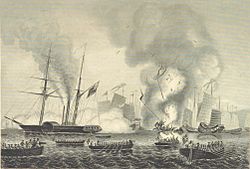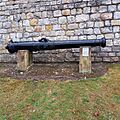Second Battle of Chuenpi facts for kids
Quick facts for kids Second Battle of Chuenpi |
|||||||||
|---|---|---|---|---|---|---|---|---|---|
| Part of the First Opium War | |||||||||
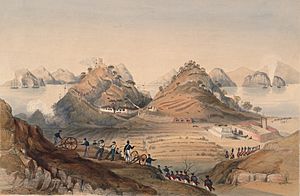 British forces advancing in Chuenpi |
|||||||||
|
|||||||||
| Belligerents | |||||||||
| Commanders and leaders | |||||||||
| James Bremer | Guan Tianpei | ||||||||
| Strength | |||||||||
| 3 ships of the line 3 frigates 2 paddle frigates 1 corvette 2 sloops 1 bomb ketch 1,500 men 3 guns2 |
15 junks 2,000 men 2 forts |
||||||||
| Casualties and losses | |||||||||
| 38 wounded | 277 killed 467 wounded 100 captured 11 junks destroyed 191 guns captured 2 forts captured |
||||||||
| 1 Cession formally ratified in the Treaty of Nanking (1842). 2 Involved in the Chuenpi landing force only. |
|||||||||
The Second Battle of Chuenpi (which in Chinese is called 第二次穿鼻之戰) was a fight between British and Chinese forces. It happened on January 7, 1841, during the First Opium War. The battle took place in the Pearl River Delta in China's Guangdong province.
The British launched an attack from both land and sea at the Humen strait, also known as the Bogue. They successfully captured the forts on the islands of Chuenpi and Taikoktow. After this battle, British representative Charles Elliot and Chinese official Qishan began talks. These talks led to an agreement called the Convention of Chuenpi on January 20. A key part of this agreement was that Hong Kong Island would be given to the British Empire. The British officially took control of the island on January 26.
Contents
Why the Battle Happened
In September 1840, the Daoguang Emperor of the Qing dynasty (China's ruling family at the time) removed his official Lin Zexu. He replaced him with Qishan. The British Foreign Secretary, Lord Palmerston, gave instructions to his representative, Charles Elliot. Elliot was told to make sure several Chinese ports were opened for trade. These ports included Canton (now Guangzhou), Amoy, Fuzhou, Ningpo, and Shanghai.
The British also wanted to gain control of at least one island. If China refused, they wanted a safe British area on the mainland. Finally, they demanded money to cover the cost of opium that had been taken by China. They also wanted money for the military expenses of the war.
Elliot tried to get these demands met through talks with Qishan. He asked for a large sum of money and for the islands of Amoy and Chusan to become British. Qishan offered less money and refused to give up any land. Elliot warned that the large British forces gathered would become impatient if talks dragged on. The year ended without a final agreement. A rumor then spread that the Chinese emperor planned to go to war. So, on January 5, 1841, Elliot prepared for an attack. He told Qishan that if no agreement was reached, an attack would begin in two days.
The Battle Begins
The British started their attack at 8:00 AM on January 7. They began from Sampanchow Island, which was about 3 miles below the Humen strait. By 9:00 AM, British ships helped land troops on Chuenpi Island. The soldiers landed without any resistance about 2 miles from the Chinese forts.
The British land forces included:
- 504 Royal Marines
- 33 Royal Artillery soldiers with cannons
- 137 sailors from various warships
- 104 soldiers from the 26th and 49th Regiments
- 607 soldiers from the 37th Madras Native Infantry
- 76 Bengal Volunteers
About 1,500 men were part of this land force. They marched about 1.5 miles and saw the upper fort. It had a deep ditch and a strong wall around it. The Chinese soldiers cheered, waved their flags, and began firing their cannons. The British cannons on a nearby hill fired back. The Chinese returned fire for about 20 minutes.
At the same time, British steamships like the Queen and Nemesis fired shells into the upper fort. Other warships, including the Calliope, Hyacinth, and Larne, attacked the lower fort. In less than an hour, the combined attack silenced the Chinese cannons. By 10:00 AM, the upper fort was captured. The Royal Marines then surrounded and stormed the lower fort.
After capturing the forts, the Nemesis attacked a group of about 15 Chinese war junks. These were led by Admiral Guan Tianpei in Anson's Bay. The junks had 7 to 11 cannons each. The Nemesis fired a special rocket that hit a junk near the admiral.
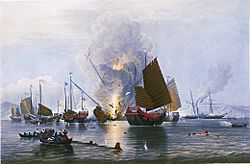
Around 11:30 AM, the Chinese on the junks lowered their flags. At noon, two small boats from the Nemesis went towards Admiral Guan's large junk. They found only one man on board, who jumped into the water when they arrived.
Meanwhile, Captain James Scott led an attack on Taikoktow Island, west of Chuenpi. When the forts there started firing at 10:20 AM, his ship, the Samarang, fired back. Other British ships joined the attack. Their firing was so strong that the Chinese cannons were quickly silenced. At 11:20 AM, British sailors landed and stormed the forts. The Chinese soldiers could not stand against the British muskets in hand-to-hand fighting. After the forts were captured, the Chinese cannons were destroyed and thrown into the river.
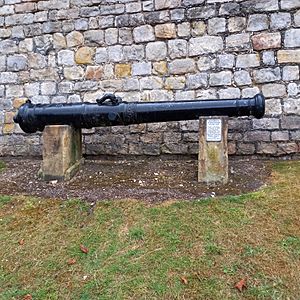
Battle Results
In total, 38 British soldiers were wounded. Many were hurt by an explosion of a large ammunition storage area after the Chuenpi fort was captured. The British commander, Commodore Bremer, praised the Chinese for fighting bravely. He reported that 500 to 600 Chinese soldiers were killed or wounded out of 2,000 men. Chinese records show 744 casualties, with 277 killed and 467 wounded. Many Chinese soldiers believed the British would not take prisoners, which led to high casualties. However, 100 Chinese prisoners who surrendered were released the next day. In the battle, 11 Chinese junks were destroyed, and 191 cannons were captured.
What Happened Next
After the battle, Elliot sent a Chinese prisoner back to Admiral Kuan. He included a letter explaining how civilized armies fight. He said that if the forts did not raise their flags the next day, they would not be attacked. On January 8, British ships sailed towards Anunghoy Island. A boat with a white flag approached them. A man from the boat asked for fighting to stop for three days. This would give Admiral Kuan time to contact Qishan. The British stopping their attack disappointed some British officers. Elliot explained that an agreement was being considered.
The Convention of Chuenpi
On January 20, after the Convention of Chuenpi was agreed upon, Elliot announced the "preliminary arrangements." These arrangements included:
- Hong Kong Island would be given to the United Kingdom.
- The British government would receive £6 million as payment.
- Britain and China would have direct and equal relations.
- Trade in Canton would open within ten days after the Chinese New Year.
They also agreed that the forts of Chuenpi and Taikoktow would be returned to the Chinese. The British would also leave Chusan Island. On January 26, the British flag (the Union Jack) was raised on Hong Kong. Commodore Bremer officially took control of the island. This was celebrated with a special rifle salute from the marines and a 21-gun salute from the warships. On January 29, Elliot announced that Chinese people on Hong Kong would follow Chinese laws, but without torture. British people and other foreigners on Hong Kong would be protected by British law.
Reactions to the Agreement
When the Chinese emperor heard the news, he was very angry. He ordered Qishan to be removed from his job and put on trial. Qishan was accused of giving Hong Kong to the "barbarians." He claimed he only pretended to agree to buy time. The court called him a traitor and sentenced him to death. He was imprisoned but later allowed to deal with the British without official rank.
On the British side, Lord Palmerston was also unhappy. On April 21, 1841, he criticized Elliot for not getting all the demands he had been given. Palmerston called Hong Kong "a barren island with hardly a house upon it." In May 1841, Henry Pottinger replaced Elliot as the British representative.
Queen Victoria wrote about these events to her uncle, King Leopold I of Belgium, on April 13.
Images for kids
-
The Nemesis (right background) destroying Chinese war junks in Anson's Bay
-
A 17th century cannon "captured from a Chinese War Junk" by Nemesis and now on display at Windsor Castle.


